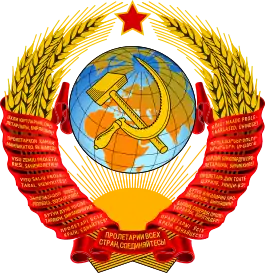Indo-Soviet Treaty of Friendship and Cooperation
The Indo–Soviet Treaty of Peace, Friendship and Cooperation was a treaty signed between India and the Soviet Union in August 1971 that specified mutual strategic cooperation. That was a significant deviation from India's previous position of non-alignment during the Cold War[1] and was a factor in the 1971 Indo-Pakistani war.
 | |
India |
Soviet Union |
|---|---|
| Wikisource has original text related to this article: |
The treaty was caused by increasing Pakistani ties with China and the United States[2][3] and played an important role in the 1971 Bangladesh Liberation War.[4] The duration of the treaty was of 20 years and it was renewed for another 20 years on 8 August 1991. Following the dissolution of the Soviet Union it was replaced by a 20-year Treaty of Indo-Russian Friendship and Cooperation during President Yeltsin's visit to New Delhi in January 1993.
Indo-Soviet relations
Early relations
India's initial relations with the Soviet Union after the former's independence were ambivalent and were guided by Nehru's decision to remain non-aligned and his government's active part in the Commonwealth of Nations. However, in February 1954, the administration of US President Dwight Eisenhower announced the decision to provide arms to Pakistan, which was followed a month later by Pakistan joining SEATO and later CENTO. Both agreements gave Pakistan sophisticated military hardware and economic aid.[4]
The developing situation alarmed India, which had uncomfortable relations with Pakistan. Since Pakistan also was near the Soviet Union, it also provided Moscow with the necessity and the opportunity to develop its relations with India, whose status as a leader of the Non-Aligned Movement would also allow the Soviets to bolster their policy in the Third World.
India and the Soviet Union, therefore, pursued similar policies based on common security threat born from the American interests in Pakistan. It was in that context that India and Soviet Union exchanged military attachés.[4]
Although Indo-Soviet co-operation occurred, Soviet military aid to India was greatly increased during the context of deteriorating Sino-Soviet and Sino-Indian relations. The 1962 Sino-Indian War caused the Sino-Pakistani axis to be another impetus for the growing co-operation between India and the Soviet Union.[4]
In 1965, Indo-Soviet relations had entered a very important phase that lasted until 1977. According to Rejaul Karim Laskar, a scholar of Indian foreign policy, 1965 to 1977 was the "golden age" of Indo-Soviet relations.[5]
1971
Following the general elections in Pakistan in March 1971, Pakistani President Yahya Khan was utterly dissatisfied with the large victory of the Awami League, the Bengali party that had its power base in East Pakistan (now Bangladesh). To pacify East Pakistan, which had voted overwhelmingly for the Awami League, he imposed martial law, a curfew, heavy censorship and the persecution of the Awami League leadership. The Pakistani military, under the orders of general Tikka Khan, used heavy gunfire for almost a week to gain control of East Pakistan's largest city Dhaka. After having secured control of the cities, they then turned to the Bengal countryside, where Tikka Khan targeted almost exclusively the Hindu population. That led to a mass exodus of mostly-Hindu Bengalis, who fled to India.
The Indian government, under the leadership of Indira Gandhi, saw itself confronted to a major humanitarian catastrophe, as eight to ten million Bengali fled from East-Pakistan to overcrowded and underfunded refugee camps in India. Gandhi decided in April that a war was needed to stop the exodus and force millions of Bengali refugees return to their homes.
However, the Pakistani leadership was very well connected, as Yahya Khan had a close personal friendship with American President Richard Nixon and harboured excellent diplomatic relations with Mao's China. Under those circumstances, Gandhi was very nervous to send an army to East Pakistan.
To her relief, the Soviet leadership was open to negotiations. The ensuing Treaty of Friendship and cooperation, signed in August 1971, was very loose but sent a strong signal to Washington and Beijing. The treaty was a strong additional incentive for Nixon and Mao to pursue their planned meeting, which took place in February 1972. Eventually, since Nixon needed Brezhnev to end the Vietnam War, frictions between both superpowers were streamlined, which paved the way for the immensely-important summit that was convened in Moscow in May 1972.[6]
References
- Hanhimaki 2004, p. 165
- Cashman & Robinson 2007, p. 236
- Rao 1973, p. 793
- Shah, SAA. "Russo-India Military-technical Cooperation". Institute of Strategic Studies, Islamabad. Archived from the original on March 14, 2007. Retrieved 2007-12-24.
- Laskar, Rejaul Karim (2013). India's Foreign Policy: An Introduction. New Delhi: Paragon International Publishers. p. 173. ISBN 978-93-83154-06-7. Retrieved 8 March 2018.
- Gary Bass, The Blood Telegram (2013), Husain Haqqani, Magnificent Delusions (2013)
Bibliography
- Cashman, G; Robinson, L.C (2007), An Introduction to the Causes of War: Patterns of Interstate Conflict from World War I to Iraq, Rowman & Littlefield, ISBN 0-7425-5510-0.
- Rao, RVR Chandrashekhar (1973), Indo-Soviet Economic Relations: Asian Survey, Vol. 13, No. 8. (Aug., 1973), pp. 793-801, University of California Press, ISSN 0004-4687.
- Hanhimaki, Jussi M. (2004), The Flawed Architect: Henry Kissinger and American Foreign Policy, Oxford University Press US, ISBN 0-19-517221-3.
